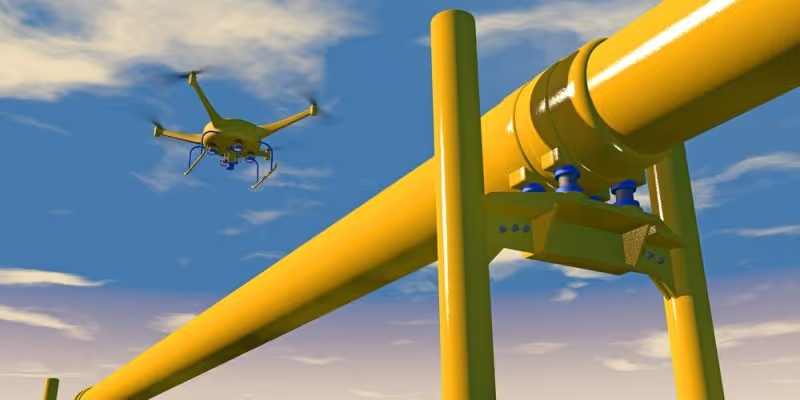The oil and gas industry is vital to daily life. However, the tasks that the industry must perform have become increasingly challenging to maintain. With thousands of miles of pipeline, frequent unplanned shutdowns, and dangerous working environments where employees are consistently exposed to highly hazardous chemicals, precarious locations, and equipment, the industry calls upon new technology for help.
Drones and automation have improved many industries, including agriculture, manufacturing, and construction, and are now beginning to tackle the oil and gas sector. While still new, the opportunities are endless.

Upstream: Improve Data Collection & Communication
Concerning upstream production and data collection, drones possess brilliant cameras and sensors, empowering them to collect data for real-time solutions or store points for later analysis. Additionally, the data that drones gather can be utilized for advanced processing, helping to pinpoint favorable drilling sites, speed up site surveys for new locations, and document the entire construction process following.
To positively transform the oil and gas industry, communication must mature. The industry requires operators to communicate with workers worldwide, challenging those working at headquarters attempting to collaborate with workers on the ground. With workers flying drones on-site and uploading the data online to a more shareable sphere, all industry ends can coordinate further inspection, from anywhere. This upstream production transformation helps maintain site awareness and ensures compliance with exploration, drilling, and well pad operations.

Midstream: Reduce Site Risk & Survey Cost
In terms of midstream production, drone technology makes it possible to reduce risks and decrease costs associated with inspection. Performing site surveys without risking employee safety is a significant issue the industry is attempting to mitigate, with hundreds of workplace fatalities and injuries reported each year. Drone data lowers risk by detecting hazardous locations where workers may be during exploration and extraction. The technology can also aid in rescue missions, providing aerial shots of safe escape routes. Thus, drone viewpoints make the industry workplace more unassailable than ever before.
The value of drone technology is emblemized by disaster, sparing resources and lives by removing the need for human labor. While natural disasters can severely damage oil and gas infrastructure, drones can alleviate this; some specialized drones can even detect seismic activity on and around sites.
Accordingly, drone insights can instantaneously alert oil and gas companies to issues, allowing them to respond quickly to mitigate damage. Unlike humans, drones have the ability to withstand extreme temperatures, as well as a variety of weather conditions, and can be controlled in remote locations through rugged terrains allowing them to get much closer to the scene - providing superior data and visuals - and perform tasks that traditional methods would be unable to execute. As a result, drones, when equipped with the right software, cut downtime by catching maintenance issues early on, avoiding the need to shut down operations for inspections, and saving the cost required to do so.
Gas emissions are another massive issue within the industry, causing a great deal of damage to the surrounding environment, immediate individuals’ health, and worsening the current climate crisis, further making drones within this industry a necessity. Already, drones equipped with specific sensors can monitor increases in gas emissions at worksites. While it is challenging to spot emissions over a large worksite area; drone automation can catch and prevent such issues.
Downstream: Transform Asset Inspections
Finally, we turn to downstream production, where drone technology has the ability to transform asset inspections. While traditional industry-wide methods are time-consuming and costly, drones are quick and autonomous. Drone software, like DroneDeploy, makes it possible to produce same-day orthomosaic maps of job sites, creating more efficient, inexpensive, accessible, and safe work. By avoiding lost working hours due to injury, a decline in medical and insurance expenses, and lastly, a reduction in reported and regulatory workplace events, site compliance, inspection efficiency, and profitability increases.
Many of our customers already utilize drone technology to improve data collection, communication, safety, and efficiency. By decreasing time, costs, and safety risks, long-term benefits of the technology abound. If you’re interested in utilizing drone software for your oil & gas operations, watch our webinar on getting started, or contact us.




